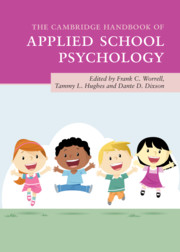Book contents
- The Cambridge Handbook of Applied School Psychology
- The Cambridge Handbook of Applied School Psychology
- Copyright page
- Contents
- Contributors
- Contributor Biographies
- Acknowledgments
- 1 Broadening the Focus of School Psychology Practice
- Part I Individual-Level Academic Interventions
- Part II Teacher- and System-Level Interventions
- 6 School-Based Interventions
- 7 Helping Teachers Use Progress Monitoring Data for Intervention Decisions
- 8 Supporting Teachers in Tier 1 Instruction: Use of Coaching and Formative Assessment
- 9 The Academic Support Index: A Tool for Contextualizing Student Data
- Part III Interventions from Educational and Social/Personality Psychology
- Part IV Behavioral and Social-Emotional Interventions
- Part V Health and Pediatric Interventions
- Part VI Family Connections and Life Transitions
- Part VII Special Populations
- Part VIII Conclusion
- Index
- References
7 - Helping Teachers Use Progress Monitoring Data for Intervention Decisions
from Part II - Teacher- and System-Level Interventions
Published online by Cambridge University Press: 18 September 2020
- The Cambridge Handbook of Applied School Psychology
- The Cambridge Handbook of Applied School Psychology
- Copyright page
- Contents
- Contributors
- Contributor Biographies
- Acknowledgments
- 1 Broadening the Focus of School Psychology Practice
- Part I Individual-Level Academic Interventions
- Part II Teacher- and System-Level Interventions
- 6 School-Based Interventions
- 7 Helping Teachers Use Progress Monitoring Data for Intervention Decisions
- 8 Supporting Teachers in Tier 1 Instruction: Use of Coaching and Formative Assessment
- 9 The Academic Support Index: A Tool for Contextualizing Student Data
- Part III Interventions from Educational and Social/Personality Psychology
- Part IV Behavioral and Social-Emotional Interventions
- Part V Health and Pediatric Interventions
- Part VI Family Connections and Life Transitions
- Part VII Special Populations
- Part VIII Conclusion
- Index
- References
Summary
Progress monitoring is an important part of any prevention and intervention model. The data can be used not only to evaluate whether the intervention is working, but also to suggest potential modifications to the intervention. This chapter defines progress monitoring, and presents data-based decision making, formative evaluation, and psychometric theory as the foundations for it. We also discuss the role of general outcome measures and subskill mastery measures in light of the last 25 years of research. Finally, the chapter discusses the role that progress monitoring has in a prevention model by providing an overview of decision-making models and how the data can be used to intensify interventions.
Keywords
Information
- Type
- Chapter
- Information
- The Cambridge Handbook of Applied School Psychology , pp. 102 - 119Publisher: Cambridge University PressPrint publication year: 2020
